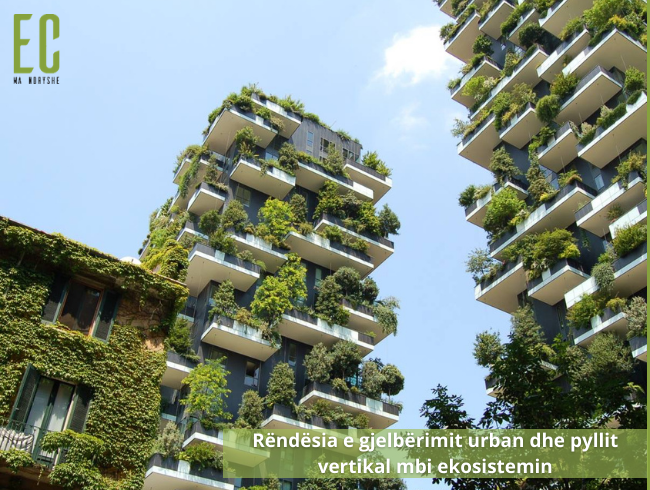The importance of urban greenery and vertical forests on the ecosystem

The practices of unplanned urbanism and the conversion of green spaces into gray are the fastest "developers" of urban areas. Acknowledging the urban heat island effects, returning to nature such as vertical greening would be alternative solutions for sustainable development.
The heat generated by traffic, industrial activities, constructions and things of the sort affect the destruction of biodiversity, causing the air temperature in urban environments to be higher than in rural areas. Green spaces make cities more eco-friendly with holistic (three-dimensional) development.
The concept of urban greening does not mean only the conventional plantings in parks and public spaces that we are used to encountering, but also other forms such as the inclusion of vertical greenery in buildings, living walls instead of facades, green roofs instead of those common etc.
It is worth noting that more than 70% of investments in Kosovo are investments in construction and this sector as a whole is the largest employer of Kosovo in the private sector, where it has doubled the number of employees in the last decade alone.
What damages green spaces the most is undoubtedly the high number of constructions without permission, where 352,836 constructions without permission were registered in Kosovo.
Only in the first 3 months of 2022 in Prishtina, more than 40 construction permits have been granted, and of this number, more than 30% are very residential buildings. While in 2021, 171 construction permits were issued, of which nearly 50% are very residential buildings with businesses. What is worth noting, based on the above data provided by the Municipality of Prishtina itself, is that most of them continue not to give priority to the proportion between the green surface and the paved surface. The implementation of the proportion, apart from the aesthetic aspect, is necessary in the first place for the psycho-physical condition of the residents who live there and then for the fulfillment of the regulation provided by the state of Kosovo.
Based on the above data obtained by ASK, the most promising solution is seen as vertical afforestation. Plants help prevent reflection and reduce solar radiation by creating an indoor microclimate that is not harmful to people, regulate air humidity, produce oxygen, absorb carbon dioxide, reduce the temperature of the building through which the demand for energy consumption is reduced, reduce noise thus facilitating the growth and sustainable development of the ecosystem.
The vertical afforestation model was first included in the project of the architect Stefano Boeri in the city of Milan in 2014. He designed two buildings that would have plants and which provided an amount of vegetation equal to 30,000 square meters of forest including wood, shrubs, trees, perennials. The buildings are designed not to hinder the growth of trees.
Buildings that include vertical forestry have also been built in China, while they are expected to be built in other countries as well, such as in the Netherlands, through which the plants will absorb 50,000 kilograms of CO2 and produce 13,750 kilograms of oxygen each year.
Such projects have already started to be designed in Albania, where according to the architect Stefano Boeri, thanks to the project that will be realized, the green area in Tirana will increase by 550 square meters.
Knowing the contribution it has to the happiness of citizens in the promotion of physical and mental health, urban greening and especially regular maintenance and cleaning should undoubtedly be the most prominent topic. This framework also includes the inclusion of vertical greenery, which must also be maintained on a regular basis.
The current state of unplanned and uncontrolled constructions in the urban system is worrying for the community and the environmental future. Urban greening should be a priority of local institutions, and not only them, but for everyone. The government should offer the most rational solutions to the complex problems of maintenance, rehabilitation and concreting of public spaces. The addition of green spaces and the implementation of design norms that integrate standards for urban greening should be the goal of all citizens and participating actors.
The promotion of community gardens, the implementation of urban agriculture, parks in each area in which citizens live and vertical afforestation of buildings are seen as the most successful models or practices in this direction.




